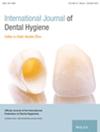In vitro evaluation of surface roughness of titanium abutments after air polishing with different abrasive powders
Abstract
Objectives
The purpose of this study was to evaluate the effects of air polishing with sodium bicarbonate and erythritol powders on surface roughness and morphological changes in titanium abutments.
Methods
A total of 45 grade V titanium discs were divided in three groups: Group A (Control) air polished with air/water; Group B, air polished with sodium bicarbonate powder; and Group C, air polished with erythritol powder. After air polishing, the samples' roughness (Sa) in micrometres were analysed with an optical profilometer. The samples' surface morphology study was conducted via scanning electronic microscope (SEM). Data were described using mean and standard deviation of roughness values (Sa). Inferential analysis was performed using the ANOVA multiple comparison test followed by Tukey's post hoc test. Both tests used a 5% level of significance.
Results
After air polishing, average roughness of group A, B and C were 0.036, 0.046 and 0.037 μm, respectively, with statistically significant differences between groups A and B (p < 0.05). No statistically significant differences were found between group A and group C, as well as between group B and C (p > 0.05). As for the morphology analysis, damages to the titanium surface were only observed in group B.
Conclusions
The study indicates that air polishing with erythritol powder maintains titanium abutment integrity better than sodium bicarbonate, which increased surface roughness and caused damage. Erythritol is preferable for minimizing surface alterations and maintaining morphological stability.

 求助内容:
求助内容: 应助结果提醒方式:
应助结果提醒方式:


